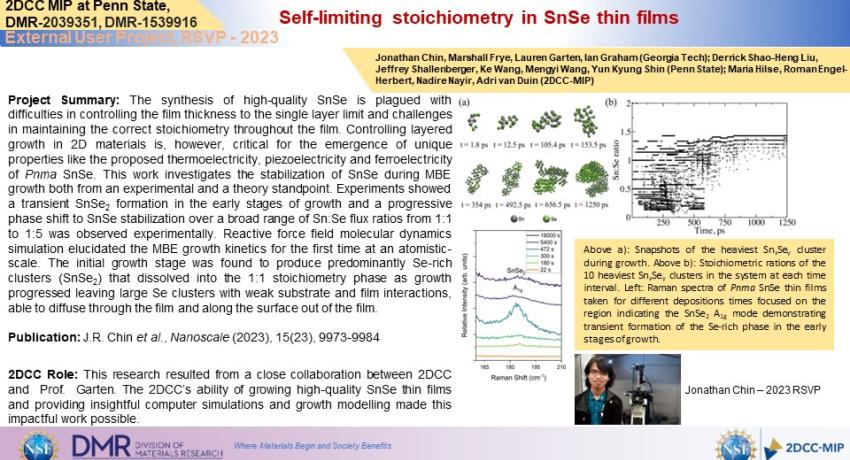The synthesis of high-quality SnSe is plagued with difficulties in controlling the film thickness to the single layer limit and challenges in maintaining the correct stoichiometry throughout the film. Controlling layered growth in 2D materials is, however, critical for the emergence of unique properties like the proposed thermoelectricity, piezoelectricity and ferroelectricity of Pnma SnSe. This work investigates the stabilization of SnSe during MBE growth both from an experimental and a theory standpoint. Experiments showed a transient SnSe2 formation in the early stages of growth and a progressive phase shift to SnSe stabilization over a broad range of Sn:Se flux ratios from 1:1 to 1:5 was observed experimentally. Reactive force field molecular dynamics simulation elucidated the MBE growth kinetics for the first time at an atomistic-scale. The initial growth stage was found to produce predominantly Se-rich clusters (SnSe2) that dissolved into the 1:1 stoichiometry phase as growth progressed leaving large Se clusters with weak substrate and film interactions, able to diffuse through the film and along the surface out of the film.
Publication: J.R. Chin et al., Nanoscale (2023), 15(23), 9973-9984
2DCC Role: This research resulted from a close collaboration between 2DCC and Prof. Garten. The 2DCC’s ability of growing high-quality SnSe thin films and providing insightful computer simulations and growth modelling made this impactful work possible.
Similarly, force field simulation of MBE growth, requiring development of force fields for Se, and Sn, and access to the materials computation center.
(If Applicable) Publication: Jonathan R. Chin, Marshall B. Frye, Derrick Shao-Heng Liu, Maria Hilse, Ion C. Graham, Jeffrey Shallenberger, Ke Wang, Roman Engel-Herbert, Mengyi Wang, Yun Kyung Shin, Nadire Nayir, Adri C. T. van Duin, and Lauren M. Garten, “Self-limiting stoichiometry in SnSe thin films”, Nanoscale (2023), 15(23), 9973-9984
Acknowledgments: The work presented has been facilitated by the Materials Innovation Platform of The Pennsylvania State University, i.e., the Two-Dimensional Crystal Consortium (2DCC-MIP) sup-ported by NSF through cooperative agreements no. DMR-1539916 and DMR-2039351. DSHL acknowledges the support of the center for 3DFerroelectric Microelectronics (3DFeM), an Energy Frontier Research Center funded by the U.S. Department of Energy, Office of Science, Office of Basic Energy Sciences Energy Frontier Research Centers program under Award Number DE-SC0021118. JC acknowledges the support of the National Science Foundation (NSF) Graduate Research Fellowship Program under Grant No. DGE-2039655.JC, MF, and LMG acknowledge the Air Force Office of Scientific Research (AFOSR) Young Investigator Award under Grant No. AWD-003701.
